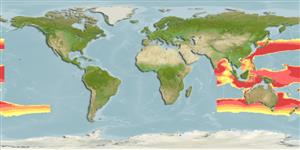Elasmobranchii (tubarões e raias) (sharks and rays) >
Squaliformes (Sleeper and dogfish sharks) >
Dalatiidae (Sleeper sharks)
Etymology: Squaliolus: Diminutive of squalus (L.), a sea-fish, usually applied to sharks, referring to small size of S. laticaudus. (See ETYFish); aliae: In honor of the Teng’s wife Huang A-li, for her “cordial help and constant encouragement” [originally spelled alii; since name honors a woman, aliae reflects the correct gender]. (See ETYFish).
Environment: milieu / climate zone / depth range / distribution range
Ecologia
marinhas batipelágico; intervalo de profundidade 200 - 2000 m (Ref. 6871). Deep-water
Western Pacific: Japan to Australia (off northwestern Australia and New South Wales).
Length at first maturity / Tamanho / Peso / Idade
Maturity: Lm ?, range 15 - ? cm
Max length : 22.0 cm TL macho/indeterminado; (Ref. 6871)
Espinhos dorsais (total): 1; Raios dorsais moles (total): 0; Espinhos anais 0; Raios anais moles: 0. The smalleye pygmy shark, Squaliolus aliae, is a very small dogfish (about 22cm) characterized by its small eye, with diameter about 46-70% of interorbital width, and with upper margin angular and chevron-shaped; upper lip with a pair of prominent lateral papillae (rarely indistinct) (Ref. 31367, 6871).Colour: dark brown to black, fin margins pale (Ref. 6871). Squaliolus are the only sharks with a fin spine on its first dorsal fin (spine sometimes concealed by skin) but not on its second dorsal fin; second dorsal fin long-based and low, about twice the length of the first dorsal fin base; first dorsal-fin base closer to pectoral fins than to pelvic fins; and caudal fin nearly symmetrical, with subterminal notch present (Ref. 247, 6871).
Possibly the smallest living shark (Ref. 6871). Found near continental and island land masses (Ref. 31367). Feeds mainly on cephalopods and small midwater bony fishes (Ref. 6871). Probably makes diurnal vertical migrations from within 200 m of the surface at night down to about 2,000 m during the day (Ref. 6871). Ovoviviparous (Ref. 6871).
Life cycle and mating behavior
Maturidade | Reprodução | Desova | Ovos | Fecundidade | Larvas
Distinct pairing with embrace (Ref. 205). Ovoviviparous but litter size unknown (Ref. 6871). Males mature at 15 cm (Ref. 31367).
Last, P.R. and J.D. Stevens, 1994. Sharks and rays of Australia. CSIRO, Australia. 513 p. (Ref. 6871)
Categoria na Lista Vermelha da IUCN (Ref. 130435)
Ameaça para o homem
Harmless
Utilização humana
Pescarias: sem interesse
Mais informação
Idade/TamanhoCrescimentoComprimento-pesoComprimento-comprimentoFrequência de comprimentoMorfometriaMorfologiaLarvasDinâmica larvarRecrutamentoAbundânciaBRUVS
ReferênciasAquaculturaPerfil para aquaculturaEstirpesGenéticaElectrophoresesHereditariedadeDoençasProcessamentoNutrientsMass conversion
ColaboradoresFotografiasStamps, Coins Misc.SonsCiguateraVelocidadeTipo de nataçãoÁrea branquialOutras referênciasCérebrosVisão
Ferramentas
Relatórios especiais
Descarregue XML
Fontes da internet
Estimates based on models
Preferred temperature (Ref.
123201): 4.6 - 10.1, mean 6.5 °C (based on 559 cells).
Phylogenetic diversity index (Ref.
82804): PD
50 = 0.7520 [Uniqueness, from 0.5 = low to 2.0 = high].
Bayesian length-weight: a=0.00372 (0.00141 - 0.00976), b=3.12 (2.89 - 3.35), in cm total length, based on LWR estimates for this (Sub)family-body shape (Ref.
93245).
Nível Trófico (Ref.
69278): 4.4 ±0.57 se; based on food items.
Resiliência (Ref.
120179): Baixo, tempo mínimo de duplicação da população 4,5 - 14 anos (Fec assumed to be <100).
Fishing Vulnerability (Ref.
59153): Low vulnerability (12 of 100).
